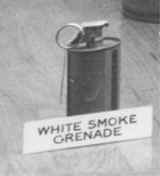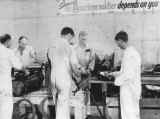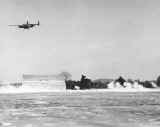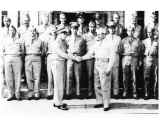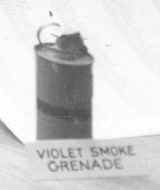1943
|
1943 Beginning this year, a particular specialty of Redstone Ordnance Plant was the manufacture of demolition blocks for the Corps of Engineers and Airborne Troops. Some of the common uses of the blocks included the demolition of bridges and other installations to delay the enemy, assault demolitions of fortifications and pillboxes, and destruction of underwater obstacles during amphibious assaults. By August 1945, Redstone had produced and shipped 11,756,000 demolition blocks. 1943 Because the extremities of the reservation were not completely fenced, a mounted guard was started at Redstone Ordnance Plant to patrol the installation's borders. The problem of feed for the horses led to the planting of corn on abandoned farmland adjacent to the stables. Huntsville Arsenal also donated several acres of hay that Redstone employees cut and baled. Following V-J Day, the horses were declared surplus property and sold. 1943 During the year, Redstone established a diversified program of outdoor activities that was highly successful. Both the women's and men's basketball and softball teams won several titles in competition with other area teams. Intramural teams were also formed. In addition, volley ball, badminton, and ping-pong facilities were set up. |
|
1943 Problems concerning the needs of Redstone Park inhabitants were worked out during this period. Great difficulty in getting adequate milk deliveries established for the project were encountered because local tradesmen were reluctant to supply commodities in short supply if doing so would deprive their regular customers in Huntsville. The distance from the city to the project also affected deliveries because of the shortage of trucks and tires for delivery purposes. 1943 to May 1944 An innovation in the Huntsville Arsenal Post Exchange (PX) operation was the cultivation of a truck garden, products of which were used in the cafeteria and sold in the PX. The PX also owned 90 hogs, fed mostly with swill from kitchens, which were to provide pork for the cafeterias. The farm was discontinued because of continuing monetary losses. |
|
15 January 1943 Huntsville Arsenal began publishing its own newspaper entitled The Patriot. The paper was published every Friday by and for the arsenal's military and civilian personnel under the direction of the Special Service Officer. Publication ceased on 25 August 1945. |
|
16 January 1943 Three old passenger railroad coaches were delivered to Redstone Ordnance Plant for use in transporting employees from Redstone Park. |

|
|
26 February 1943 Redstone Ordnance Plant was redesignated Redstone Arsenal. March 1943 One of Huntsville Arsenal's H Filling Plant buildings was converted for use as an Incendiary Oil Plant. As of 30 June 1945, four different type of incendiary oil munitions had been produced. Each time a new munition was put into production, a redesign and alteration of the existing facilities had to be accomplished. Aside from the M-47 program, which operated during a period when more men were available, operations were carried out using about 60 percent women. It was found that women could efficiently handle almost any assembly operation that did not require more than moderate physical exertion. 15 March 1943 Production of thionyl chloride, a drying and chlorinating agent used in the treatment of crude Lewisite, began at Huntsville Arsenal. It was discontinued on 4 October 1943 and never resumed. 20 March 1943 Another plant contributing to the manufacture of Lewisite at Huntsville Arsenal, the arsenic trichloride plant, began operation. Placed on standby until 11 November 1943, the plant's equipment was subsequently removed to make way for a plasticized white phosphorus plant. |
|
22 March 1943 Production of the M-1 smoke pot began at Huntsville Arsenal. This first run continued until 30 April 1943. A second run started on 10 August 1943 and was concluded on 15 January 1944. |
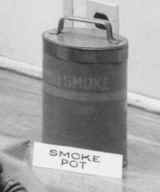
|
|
April 1943 The first Public Relations Officer for Huntsville Arsenal was appointed. April 1943 In accordance with federal government direction, victory gardens were started at Redstone Arsenal. Though given a fair trial, according to contemporary accounts "by no stretch of the imagination could it be said they were successful." 17 April 1943 The H.K. Ferguson Company of Cleveland, Ohio, completed construction of a thionyl chloride plant at Huntsville Arsenal. The purpose of this plant was to supply the drying and chlorinating agent used in the treatment of crude Lewisite to decrease sludge formation. Although the plant was not actually completed until April, production operations were initiated on 15 March 1943. Production was discontinued on 4 October 1943. 24 April 1943 In compliance with Circular 74 of the War Department, a Legal Assistant Officer was established at Redstone Arsenal to provide legal assistance to military personnel and their dependents. May 1943 Huntsville Arsenal began producing M-1 105mm canisters. Several widely scattered buildings were used to produce this type of smoke munition to reduce the fire hazard. After being discontinued and resumed several different times, production finally ceased in January 1945. May 1943 Beginning this month, Huntsville Arsenal filled spot orders for the ANM-3 grenade. This munition was actually the red M-16 or red M-18 grenade placed in an outer metal container with retainer fins. The last order was filled in January 1945. A total of 155,725 grenades were produced in WWII. 1 May 1943 Huntsville Arsenal started manufacturing the M-1 fuze, a component of the M-69 bomb. The first facilities used for fuze assembly were designed for about 10,000 fuzes per 8-hour period. The best performance reached a maximum sustained production rate of 16,000 per 8-hour period. Manufacture of the M-1 fuze continued intermittently until 7 July 1945, at which time it was discontinued because the M-69 bomb was no longer being produced at Huntsville Arsenal. 4 May 1943 Huntsville Arsenal started producing M-2 canisters for colored smokes which were to be shipped to Redstone Arsenal for assembly into base ejection shells. The last canister was produced on 5 July 1945. 5 May 1943 Redstone Arsenal became the first activity in the Fourth Service Command privileged to fly the Minuteman "T" banner conferred by the Treasury Department on those installations having over 90 percent of their employees investing 10 percent of their earnings in War Savings Bonds. By this time, 93.84 percent of Redstone employees were investing 10.56 percent of their gross payroll in War Savings Bonds. 6 May 1943 An explosion, or series of one major explosion and three smaller ones, occurred at one of Huntsville Arsenal's mustard gas manufacturing facilities, resulting in the death of two persons and the serious injury of a third. 22 May 1943 The first Commander of Huntsville Arsenal, BG Rollo C. Ditto, transferred to a new assignment. June 1943 A 300-unit housing project for black employees of Huntsville and Redstone Arsenals was opened. Known as Binford Court in honor of Henry C. Binford, a well-known educator and prominent member of Huntsville's black community at the turn of the century, this project was located close to the city of Huntsville. It provided badly needed housing relief to this group of arsenal workers. 15 June 1943 It was announced that Redstone Arsenal would comply with a directive of the War Manpower Commission by not releasing necessary employees to take employment elsewhere for their own advantage. The purpose of this directive was to stabilize the workforce as much as possible in their present positions to cut down on labor turnover and frequent transfers from one war agency to another. |
|
July 1943 The first mechanical equipment for use at Huntsville Chemical Warfare Depot was introduced. The new forklifts, tractors, and trailers materially reduced handling costs and labor. Initially operation of the depot was totally manual. July 1943 A 76mm artillery munition first developed at the request of the British for screening and marking, the M-89 smoke shell began production at Huntsville Arsenal. It was discontinued in October 1944. 9 July 1943 Production of carbonyl iron began at Huntsville Arsenal. This facility, constructed by the H.K. Ferguson Company, was established primarily to serve as a standby plant in the event that the only successful carbonyl iron plant then in operation (General Aniline Works, Grasselli, New Jersey) should cease production. Instructions were to produce 125,000 pounds of carbonyl iron and then put the plant on standby. When the quota was reached on 26 October 1943, the plant was shut down. 28 July 1943 In keeping with guidance from the War Department, Redstone Arsenal established an employee suggestion program. The Civilian Personnel Branch set up 17 boxes at various points around the post and offered rewards ranging from $5 to $250 for acceptable suggestions. August 1943 As an incentive toward better employee morale and in accordance with directives from higher headquarters, Huntsville Arsenal initiated the Suggestion for Victory Program. The first suggestion was received on 7 August 1943. 1 August 1943 Effective this date, per diem employees at Redstone Arsenal were paid on a biweekly basis, receiving their checks every other Saturday. This change was made so employees could shop on Saturday evenings after work and count on a regular day twice a month on which to receive their pay. 1 August 1943 Production of the AN-M14 grenade, a modified thermate incendiary that could generate enough heat to melt through a sheet of 3/8-inch steel, began at Huntsville Arsenal. Manufacture of this item ceased in December 1943. 7 August 1943 The Office, Chief of Ordnance informed the Redstone Arsenal Commanding Officer of its plan to turn over operation of the installation to the Concan Ordnance Company, Inc., a subsidiary of the Continental Can Company. This was in keeping with Ordnance Department policy of having certain government establishments operated by industry so that needed military personnel could be released for troop duty. However, negotiations between the Ordnance Department and Concan Ordnance broke off in November 1943, with the Army retaining management of arsenal operations. 10 August 1943 The War Department changed the name of the Huntsville Chemical Warfare Depot to Gulf Chemical Warfare Depot to avoid confusion with Huntsville Arsenal. 14 August 1943 The first serious explosion at Redstone Arsenal occurred at 2326 hours on Line #1, killing one woman and injuring seven other workers. September 1943 It was announced that LTC Carroll D. Hudson had been assigned to a new post with the Field Director of Ammunition Plants in St. Louis, Missouri. This reassignment was part of the effort to contract out the operation of Redstone Arsenal to the Concan Ordnance Company, Inc. 30 September 1943 Huntsville Arsenal won the privilege of flying the Minuteman "T" banner. It actually received its flag on 17 November 1943. October 1943 Production began in earnest at the two chlorine plants constructed on Huntsville Arsenal by the H.K. Ferguson Company of Cleveland, Ohio. Production of the chlorine, which was used for the manufacture of mustard gas, continued until July 1945. The chlorine plants were shut down and placed on standby on 1 September 1945. |
|
9 October 1943 The original contracts and change orders thereto for the construction of Huntsville Arsenal and the Gulf Chemical Warfare Depot (later known as the Gulf Chemical Depot) were terminated. 17 October 1943 Redstone Arsenal officials announced that service awards would be conferred upon eligible civilian employees. There were three classes of awards: the Emblem for Civilian Service, the Emblem for Meritorious Civilian Service, and the Emblem for Exceptional Civilian Service. Appropriate ceremonies were held on 8 December 1943 when 1793 employees received awards. |
|
December 1943 The first members of the Women's Army Corps arrived at Huntsville Arsenal for administrative duty. December 1943 Huntsville Arsenal began producing tear gas grenades. This manufacturing effort continued until May 1944. December 1943 Huntsville Arsenal first began producing the M-20 rifle grenade. Production of this smoke munition continued intermittently until February 1945. 20 December 1943 The manufacture of the M-7 tear gas grenade began at Huntsville Arsenal and was completed on schedule on 18 March 1944. The total produced was 243,020. |
The Pre-Missile Era:
Introduction,
1941
,
1942
,
1943
,
1944
,
1945
,
1946 & 1947
,
1948 & 1949

